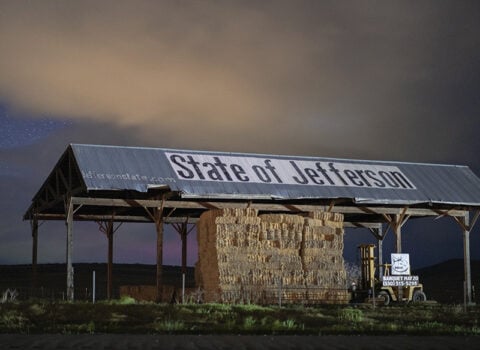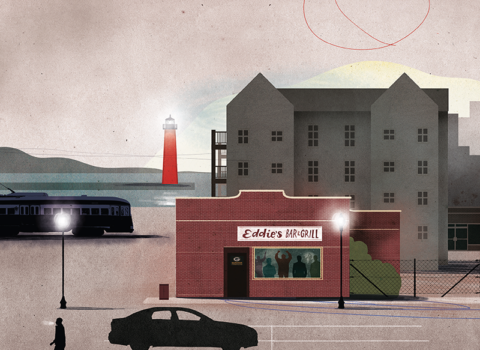The squatter camp outside Lawley township, in the southwest of Johannesburg, stretches for miles against a bare hillside, without electricity, water, or toilets. I visited on a blustery morning in October with a local journalist named Mophethe Thebe, who spent much of his childhood in the area. As we drove toward the settlement he pointed out land that had been abandoned by white Afrikaner farmers after the end of apartheid in 1994, and had since been taken over by impoverished black settlers who built over the former farms with half-paved roadways and tiny brick houses. You could still see stands of headstones inscribed in Afrikaans, all that remained visible of the former inhabitants.
Thebe warned me that his family had participated in a gang conflict here, part of the endless “taxi wars,” which have made killings of drivers a common occurrence. “It’s no problem,” he said. “I’m very popular. But I like to come in a different car every time for safety.” Later, he would point casually at a lot and say it was the place where his father-in-law had been murdered in a shoot-out.
We were looking for a boyhood friend of Thebe’s, the local head of the Economic Freedom Fighters. In recent months, both the EFF and left-wing members of the ruling African National Congress, which has governed South Africa since 1994, have led occupations of vacant land mostly owned either by the government or members of the white Afrikaans-speaking population, who would once have been termed Boers. Boer means “farmer” in Afrikaans, and their descendants see agriculture as their history and identity, as well as their rightful inheritance. Even a quarter century after the end of apartheid, 72 percent of privately held farmland in South Africa is owned by whites, who now make up just 8 percent of the country’s population of over fifty-six million. Blacks, 81 percent of South Africa’s population, own only 4 percent of the country’s rural land. It’s this imbalance that has led as many as five million squatters to occupy land like that in Lawley over the last two decades.
A windstorm was blowing in as we came into the settlement. The pavement ended. We got out of the car and walked up a dirt track. A man with a gray beard and a tattered military jacket appeared. “Welcome to our squatter camp!” he said with a broad smile. He was fifty-five, and had participated in the land grab because he hadn’t had work in years and couldn’t pay the rent in the brick house he’d been sharing. I gave him a cigarette and asked how the land had been settled. “I don’t know who owns it,” he said. “We just came. They say the white man is in America now.”
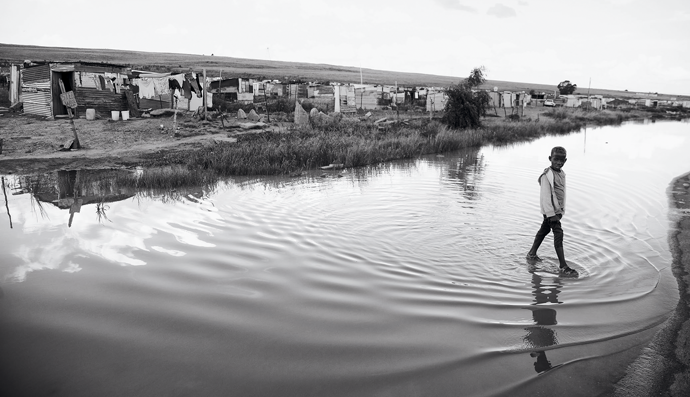
A flooded street outside Lawley township, Johannesburg, January 2019. Photograph by James Oatway for Harper’s Magazine © The artist
With twenty-five seats in the National Assembly and millions of supporters, the EFF has led many of these land grabs across the country. In so doing, the organization has helped make land reform the country’s defining issue, mobilizing the most active of its members to seize scores of massive tracts in recent years, augmenting the far greater number of settlements that have simply been erected by informal squatters with no explicit political agenda. There have been, by one estimate, seventy violent clashes on land grabs since 2013, usually conflicts between residents and police or hired security forces.
Under pressure from EFF and its supporters, the business-friendly, moderate president, Cyril Ramaphosa, adopted a policy of “expropriation without compensation” last winter, and began the process of changing the country’s constitution to allow for land seizures. The government subsequently held a series of raucous and vitriolic public consultations around the country, which were often packed with yelling EFF supporters. On November 15, 2018, the Parliament’s Constitutional Review Committee approved the proposed amendment, allowing debate on the issue to begin, and setting up a decisive vote for later this year that would allow, according to an ANC official, land seizures to be a “legitimate option” in an effort to create “mixed ownership of land.”
The storm picked up as we waited at the camp. We couldn’t find Thebe’s friend, so we introduced ourselves to several very large men at the door of a shanty and to a trio of old women who scowled as we entered. We packed in as the wind rattled the walls, and a big forty-seven-year-old named Auriel Ramokgola, an EFF representative, took over speaking for the room. He told us that this land they’d seized mostly belonged to the state, though he admitted pockets had been owned by white war veterans who’d been granted it as a reward for service by the apartheid government.
“The way it is now, the whites have a great deal of land,” Ramokgola said. “Whereas the black, you think should be having the majority of this land—we don’t have anything. Land expropriation is the only answer that we can see. But we want to say: there is no one who is being persecuted—we are not killing anyone, we are not fighting anyone. We are only taking what we think is ours.”

Members of the Economic Freedom Fighters campaign in Diepsloot township, Johannesburg. Photograph by James Oatway for Harper’s Magazine © The artist.
To the extent that news about land reform in South Africa has reached international audiences at all, it’s been refracted through the lens of a narrative promoted by white conservatives about a supposed “white genocide”—killings of mostly Afrikaner farmers—equating land redistribution with race war. Even though there’s no direct connection between murders of white farmers and land reform, an idea has nonetheless taken hold in the international media of landowners under murderous assault by the black masses, the clearest symbol that in twenty-five years of post-apartheid majority rule whites have become a persecuted minority.
It’s easy to forget today, in the years since Nelson Mandela has become a secular liberal saint, that the victory over apartheid was not a product of tidy pacifist resistance to political injustice. The ANC’s guiding Freedom Charter, adopted in 1955, declared the need for land redistribution—“The Land Shall Be Shared Among Those Who Work It!”—and the document is a revolutionary manifesto, calling not just for democracy and political equality but for the redistribution of land and the nationalization of mines and industry. The charter recognized that political equality would be meaningless without wealth redistribution, since whites had long ago handed themselves control of the country’s natural resources: one of the first pieces of segregationist legislation passed by the newly independent Union of South Africa was the 1913 Natives Land Act, which barred whites from buying property from blacks, and vice versa, at a time when about 90 percent of the country’s land was already in white hands. This law codified white territorial control, and it presaged the apartheid government’s creation of jerry-rigged “homelands” for the black population, with the aim of relegating the entire black population to 13 percent of the country’s landmass.
In the ensuing decades of the twentieth century, the majority of whites lived in fantastic comfort, at the pinnacle of a virtual slave state with protected industries, enjoying a legacy of infrastructure paid for by hard currency that was always in ready supply from the country’s mines. In the case of South Africa’s rich agriculturalists, a tiny minority lorded over huge farms maintained on a plantationlike system with cheap, disposable labor always at hand. The EFF and others currently calling for redistribution learned a lesson from this: it is hard to control the flow of transnational capital, but it’s not so hard to control wealth derived from the ground. “Without the land,” the EFF’s deputy head, Floyd Shivambu, said recently, “you won’t be able to economically empower the black majority.”
In 1994, after years of guerrilla conflict and agitation, white supremacy didn’t fall through peaceful protest—it was a surrender, an acknowledgment that the Afrikaners had lost a multifront war for power. But this surrender came with a wary eye to the future. It was a calculated and successful maneuver to avoid the sort of reckoning that would have accompanied a full-scale revolution, a sudden collapse of the apartheid government, and a chance for the ANC’s leftists and their allies to implement the more radical portions of the Freedom Charter. These goals were mostly set aside in the happy early days of democracy when the ANC won the country’s first free elections and was in no mood to inflame the hundreds of thousands of well-armed and highly trained Afrikaners who had fought in the bush wars and might be inclined to fight for the creation of a separate white state. The new South Africa needed international investment and acceptance, and the World Bank was hardly going to approve of plans to nationalize the country’s farmland and mines. Instead, ANC leaders chose a path of reconciliation and adopted a policy of “willing buyer, willing seller,” by which they hoped to coax white farmers into selling land at market prices to be redistributed. But very few farmers sold out, and most land remained in white hands.
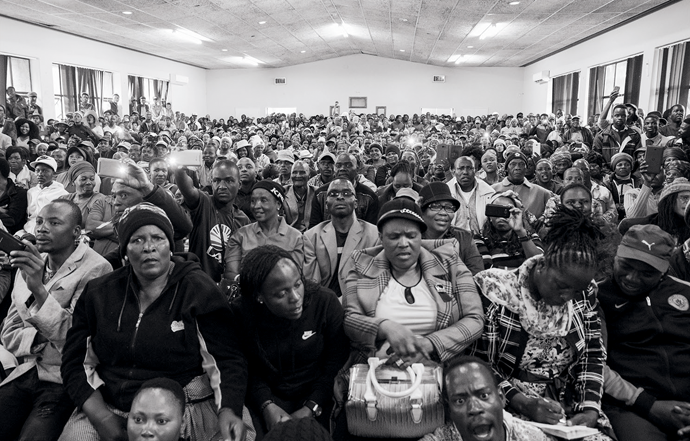
A hearing to gauge public opinion on a proposed amendment to the South African constitution that would allow for land seizures, Tzaneen, Limpopo, July 2018. Photograph by Madelene Cronjé © The artist
Meanwhile, post-apartheid, blacks were suddenly free to move to cities, and millions began a massive rural-to-urban migration that continues to this day, augmented by millions more desperately poor immigrants from Zimbabwe and Mozambique. Newly arrived migrants congregated wherever they could hope to find work, building informal settlements of shacks, often on parcels they seized from farmers or the government, and waited, hoping the authorities might move in and offer services or build permanent housing, even as the squatter camps continued to grow with new arrivals.
Today, fourteen million South Africans live in extreme poverty, often in informal settlements or conditions that are no better. There are a tiny number of whites who live in squatter camps—13,310 of them, according to a 2016 government estimate—and the plight of this minute slice of the South African poor has been very heavily reported on. In 2013, the BBC repeated a wildly inflated estimate by “Afrikaner-rights” activists that up to four hundred thousand whites were living in camps, which is a number that it later became clear the activists had made up more or less on the spot. It has now been repeated countless times, but it’s hard to find much reporting at all about the conditions of the millions of blacks living in camps.
With the population growing rapidly and migration still ongoing, the land issue has exploded. One notorious settlement I saw in Johannesburg, called Diepsloot, is home to over one hundred fifty thousand people. There are millions upon millions of people with nowhere to go in a country where everywhere you look there are vast tracts of wide-open, white-owned land, occupied by nothing but sheep and wandering guinea fowl.
The EFF was born out of rage at this situation. The group advocates wholesale nationalization of the country’s land—an idea that has actually been tried with some success in neighboring Mozambique, where all land is owned by the government, and given out to farmers and builders via long-term leases—though the ANC leadership, wary of international condemnation, and of the economic collapse that followed Zimbabwe’s chaotic and violent takeover of white-owned land in the early 2000s, has adopted a more moderate tone. EFF’s leader, Julius Malema, once a chubby firebrand with a taste for flashy cars and watches, founded the organization after being expelled from the ANC in 2012, and he quickly grew it into the third-largest political party in the country and an unpredictable threat on the ANC’s left flank. “The land issue has been with us too long,” he said in 2014. “I can’t be everywhere. I am not the Holy Spirit. So you must be part of the occupation of land everywhere else in South Africa.” As head of the EFF, he took the title of “commander in chief,” and adopted the party’s now-ubiquitous uniform of a red shirt and red beret. The fervor of his followers, coupled with the radicalism of the EFF’s politics, terrify some whites—a reaction he seems to enjoy provoking. When an interviewer recently confronted Malema for allegedly advocating the murder of white landowners, he denied the charge, saying he hadn’t called for whites’ “slaughter . . . at least for now.”

An informal settlement known as Kokotela, because of the sound made during the construction of corrugated iron houses, near Lawley township, Johannesburg. Photograph by James Oatway for Harper’s Magazine © The artist
I wasn’t in South Africa long before I got used to being handed a phone with an image called up of, say, a best friend shot point-blank in the back of the head, or a seventy-three-year-old father beaten to the point that his skull was pulled off his brain like tortilla chips. There are massive WhatsApp chains and Facebook groups that share these kinds of photos, and to scroll through them is enough to turn you paranoid and almost frantic. You get accustomed to the bloody photos, but the dark part is how hard it is to understand the attacks: Why would people force children to watch their mother’s gang-rape, creep up to shoot an old couple as they sleep in bed, force a twelve-year-old into a bathtub and drown him in boiling water?
It’s a simple fact that there is an element of racial vitriol to some murders of white farmers. One recent attack came two months after vandals painted the words “Kill the Boer,” which is the title of a favorite song of Malema’s, on the door of the victims’ farmhouse. The attacks are often elaborately and senselessly violent. But farmers are only one of a broad host of people in South Africa who are at a high risk of being murdered—night-shift workers and Uber drivers, for example, are in greater statistical danger. And international media, which have amplified the idea that so-called farm murders are a major concern, has been oblivious to a key fact: last year, in a country where almost twenty thousand people were slain, most of them black, there were only sixty-two farm murders, according to government statistics. Sixty-two. According to one of the country’s largest agricultural associations, murders of farmers are at a twenty-year low. And not all of the victims are even white. In a town called Krugersdorp I investigated the recent killing of a man named Aron Mutavhatsindi. His alleged murder took place on a farm, but he was black—shot at range by a white security guard who saw him driving a tractor and decided that he was stealing it.
So how is it that the land question and “farm murder” narrative became intertwined? The answer, to a large extent, is a man named Simon Roche, a leader of a Christian survivalist group, the Suidlanders (pronounced Seit-landers, and meaning southlanders in Afrikaans), who claim over one hundred thousand members or supporters, all white, and who have forged deep ties to American white supremacists and far-right figures such as Alex Jones. Roche has worked to link—especially to credulous international audiences—the issue of farm attacks with the threat of land expropriation. Malema has played on this theme, too—once tweeting “maybe, maybe not” when he was accused of encouraging farm attacks—but the truth is that most land occupations happen peacefully, and there appears to be no record of an EFF-led occupation resulting in murder. Farm murders happen, but they have little to do directly with land occupations.
I met Roche one day in Bloemfontein, and he drove me into the scrub desert of the Northern Cape, where he is preparing for civil war. He is a burly, earnest, and slightly disheveled forty-eight-year-old, who, like all of his fellow Suidlanders, follows the teachings of an Afrikaner prophet named Siener van Rensburg, who served as a spiritual guide and military adviser during the second Boer War against the British. The Suidlanders believe van Rensburg prophesied a war that would be both the beginning of a marauding massacre of whites in South Africa and the clarion signal of a World War III.
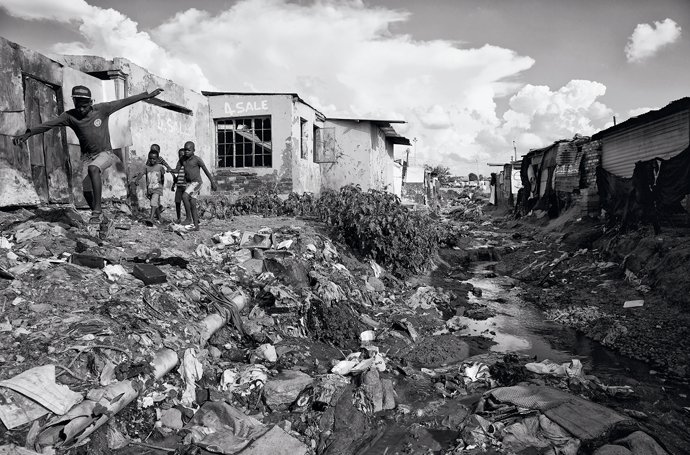
Children walk alongside a polluted stream in Diepsloot township, Johannesburg. Photograph by James Oatway for Harper’s Magazine © The artist
Today, the most extreme of van Rensburg’s disciples have a plan to retreat to an all-white redoubt in the desert, where they’ll preserve the core of their nation and live as a tribe of the pure. They imagine that they are a part of an international front fighting against the ever-busy “globalists,” who are facilitating the destruction of Christian civilization and white people everywhere by means of open borders and capital-driven globalization. And they have quietly built a worldwide following, finding that, at least on this last point, many Europeans and Americans agree with them.
Roche and I drove past vast tracts of white-owned farmland where neat and isolated houses sat in stark juxtaposition to squalid little settlements where the area’s black population was packed in. He pointed out a trio of silos to our right. “I can’t say if those have any part in” the Suidlanders’ plan for civil war, Roche said, “but it might be interesting to you that silos figure heavily in our national emergency plan. We keep track of the location and use of them.” He claimed that he had well-placed contacts in governments around the world, though he didn’t mention, and seemed to want to conceal, that he’d just received an official delegation from the German Bundestag, organized by a parliamentarian from the right-wing AfD party. A small ridge rose behind the farm with the silos. “And beyond there is a military installation. Which obviously we keep track of as well.” Secreted in the country around us, in caches disguised as graves, he had laid out his own personal matériel for the coming war. He thought it a bad look for someone as public as him to talk about weapons he might own, but the first place we stopped was a gun shop, where he was having a hunting rifle fitted with a scope.
Roche was twenty-three in 1994, when democracy finally came, and full of enthusiasm for the project of a new South Africa. In his thirties, he got into event planning, working closely with the ANC. He claims he was asked in 2008 to oversee planning for Nelson Mandela’s funeral. But in response to developments such as Black Economic Empowerment policies, which he saw as cutting qualified whites out of jobs, he began to see himself as less of a South African, and more of a white South African, and now he saw farm murders as part of a secret plot to fulfill the unachieved aims of a socialist revolution. He joined the Suidlanders in 2015, and soon left his event work in Johannesburg and moved to a Suidlanders’ enclave called Vanderkloof, to prepare for the moment when the civil war would erupt. “I know we had to give something as white people,” he told me. “But they take and take and take, and now we’ve given enough.” It’s this resentment that connects him to other aggrieved whites across the world, and it was striking to hear his words and think how comfortably they’d fit in the mouths of conservative friends of mine in the United States, talking about immigrants or Black Lives Matter.
Personally, I had come to South Africa with a sense of despair, bringing with me a question about whether it was possible that the only real answers left to the issue of whiteness were exactly the options presented by Roche and his racist allies: a choice between a power-obsessed vision of innate white superiority, which I would never share, or a kind of permanent self-loathing and apology for sins of the past, which I did not think was very workable as a politics. I’d wanted to come meet Roche to see where he—like so many other whites around the world recently—had gone wrong.
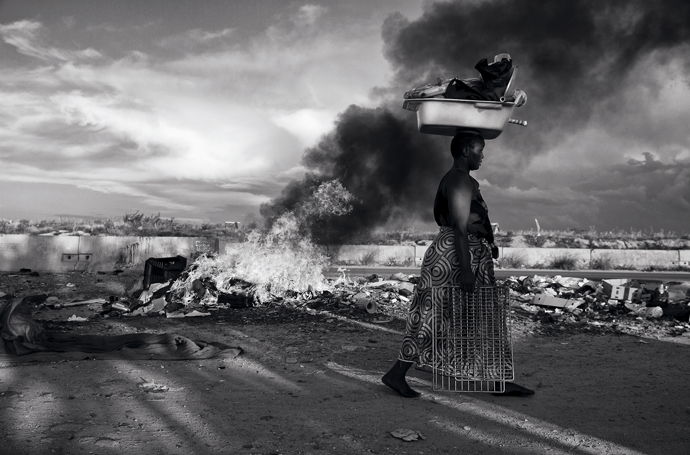
A street vendor passing a heap of burning trash, Diepsloot township, Johannesburg. Photograph by James Oatway for Harper’s Magazine © The artist
We arrived at Roche’s spare little home in Vanderkloof, a prosperous Afrikaner town with one small grocery store, two bars, and the feel of a cross between a merry Swiss village and a dystopian garrison city, which in some sense it is. It sits high in the steep red-rock hills above the reservoir formed by the massive Vanderkloof Dam, on the Orange River. It is in an area that’s a traditional stronghold of the Boers, only a short drive away from the whites-only town of Orania, which since the 1990s has served as a refuge from integration and a first step toward Afrikaner self-rule. Vanderkloof itself has one non-white resident, a self-mockingly funny and slightly pained-seeming man who serves as a senior official in the local ANC, while the rest of the nearby non-white population lives down a road past the local dump in a squalid assemblage of mud-brick houses separated by rutted dirt streets.
Roche and I went for a beer at an open-air bar overlooking the reservoir. André Coetzee, a balding, tan, and dapper Afrikaner who gave off an air of knowing much more than he wanted to say, came and joined us. In March 2017, Roche and Coetzee took the money from the sale of a hundred prize Angora goats and used it to finance a trip to America, where they’d hoped to raise money but ended up seeding the farm-murder narrative into the American far-right’s collective consciousness. In Newport Beach, California, a notoriously anti-Semitic “think tank” called the Institute for Historical Review invited Roche to give a speech. He spoke to a slightly befuddled audience of old, sweater-wearing southern Californians, telling them about van Rensburg’s prophecies and how the Suidlanders were in their estimation the “world’s largest civil defense organization.” They had been constituted, he said, by a mysterious former South African Defence Force intelligence officer named Gustav Müller—an imposing ex-farmer reportedly with several bankruptcies to his name, who has long been a target of South Africa’s intelligence services but has avoided successful prosecution and has taken it upon himself to interpret van Rensburg’s prophecies and lead his people in the coming civil war.
This speech, warning that events in South Africa were only a hint of what would soon come to the West, went over relatively well, and Roche began cold-calling white supremacists around the country. There is a recording of at least one of these calls, and it is slightly funny to listen to: in it, an aggressively modest and bumbling Roche calls a prominent white-supremacist blogger named Brad Griffin, thinking that Griffin has a radio show. “We are interested in getting as much coverage as possible,” he said, “for the simple reason that our president is now talking about taking back all of the land.” Griffin agreed to write about the Suidlanders, and very quickly Roche began to find other takers. By March 26, 2017, he was appearing on a livestream with Mike Cernovich, a conspiracy theorist who is a favorite of Donald Trump Jr., who once said that Cernovich deserves to win a Pulitzer. Roche then showed up unannounced at the Infowars headquarters in Austin, Texas. He has now appeared on Alex Jones’s show three times.
After Coetzee returned to South Africa, Roche kept up a madcap Kerouac-meets-the-Klan sort of tour, reveling in the moment, riding Greyhound buses and hitching rides across the United States. He met Nathan Damigo, of the prominent “alt-right” group Identity Evropa, who gave him $341 for bus fare and food. He was asked to be a speaker at the 2017 American Renaissance conference, a major gathering for white supremacists. He went to Charlottesville, Virginia, for the Unite the Right rally along with white supremacists like Christopher Cantwell, the so-called “crying Nazi” made famous by a Vice documentary on the protests. Matthew Heimbach, a key organizer of the event, gave money to the Suidlanders, according to the investigative website Right Wing Watch, and in November 2018 would travel to Little Rock, Arkansas, helping to lead a protest over white genocide in South Africa. “We were [in Charlottesville] as observers, of course,” Roche told me. “But it was obvious what side we were on. And none of the violence came from our side.” Cantwell was later arrested for his part in violence that day.
The trip built Roche a platform among whites all over the world who thought that their societies were besieged by tides of immigration and by minorities demanding redress for centuries of slavery, racism, and colonization. Roche assured them they had apologized enough. This was a message that, as it turned out, fit neatly with the worldview of the president of the United States. It’s impossible to say whether Roche’s appeals to white nationalists filtered up to Donald Trump, but by managing to be interviewed by Cernovich and on Infowars—a show Trump himself has appeared on and claims to admire—he brought his message to Trump’s core followers.
In April 2018, an Identity Evropa member went to a Breitbart town hall event and stood up to ask Ann Coulter a question: “Why do you think the mainstream media has been silent on the genocide of white farmers in South Africa?” The crowd erupted in applause. “I am so glad you asked that question,” she said. “No one under fifty is getting his news from the mainstream media anymore.” She said she had just done an event in Boulder, Colorado, with college students. “Every conservative question,” she said, “was about South Africa.”
As is often the case with the right in the United States, the extreme version of a narrative is aided by more mainstream figures who give fringe politics a sheen of respectability and bring them to an even wider audience. In a similar way, Roche has been aided by the efforts of Ernst Roets, the deputy head of AfriForum, a largely white and Afrikaans organization that claims to be the continent’s largest civil-rights group, with a total membership they estimate at around 215,000, which if true is a huge portion of the country’s 2.7 million Afrikaners. In May 2018, Roets took his own trip to America where, in Washington, D.C., he bumped into the US national security adviser, John Bolton, at an event and gave him a book he’d authored on farm murders, titled Kill the Boer, accusing the government of being “complicit” in the attacks. “We don’t expect that Donald Trump would make it his priority to fix the crisis in South Africa,” Roets told me. “That’s not going to happen. But what we do know is that the ANC has had this wind of international approvals, given that it’s seen as the party of Nelson Mandela and the party of liberation and so forth. So they’ve sort of been given a free pass, and I know it’s starting to crumble that perception of them.”
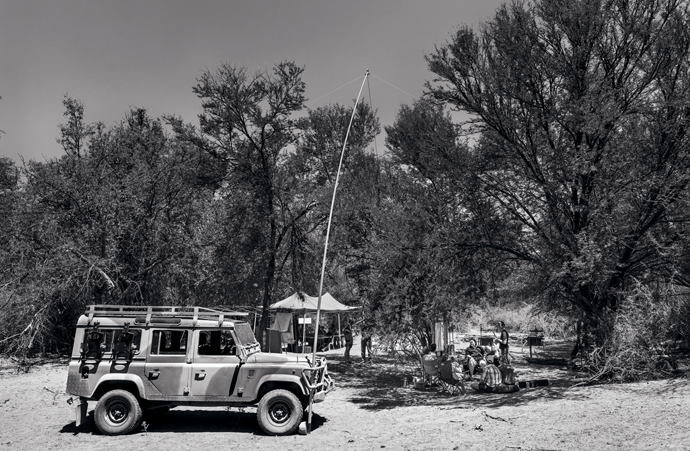
Suidlanders consult radios and maps on a farm in Vanderkloof, December 2016. Photograph © Brent Stirton/Getty Images Reportage
During his trip in May, Roets appeared on television as a guest of Tucker Carlson on Fox News, who led off the segment by saying outright that whites in South Africa were the victims of a genocidal plot. “South Africa is a diverse country,” Carlson said, “but the South African government would like to make it much less diverse.” He said that white farmers were being “targeted in a wave of barbaric and horrifying murders,” and darkly and falsely claimed that the government’s response to the issue had been to initiate the land expropriation process.
On August 22, Carlson ran another segment about what he’d called “a racist land grab” in South Africa, and Donald Trump responded the next morning with an alarmed tweet that described “farm seizures . . . and large scale killing of farmers,” which was curious, because the segment he tweeted in response to hadn’t actually focused on farm murders. He had already imbibed, from one source or another, the “white genocide” narrative. He ordered Secretary of State Mike Pompeo to study the issue, and suddenly the item was leading off newscasts and newspaper homepages around the world. a white farmer is killed every five days in south africa . . . ran a lurid and false Newsweek headline, lazily and irresponsibly attributing their claim to “activists” from South Africa, and authorities do nothing about it.
“Something like four hundred white farmers have been murdered—brutally murdered, over the last twelve months,” Australia’s former prime minister, Tony Abbott, said at the time, directly linking farm murders with land expropriation, and using a figure that was so wildly inflated that it could only have been invented wholesale or taken from extreme-right propaganda. “Just imagine the reaction here in Australia if a comparable number of farmers had been brutally murdered by squatters intent on driving them off their land.”
There was no doubt in Roche’s mind that he was part of a swelling global movement. “Donald Trump gave conservatives—the people who care about their culture and their people—the freedom to stick their head above the parapet,” he told me back at the bar in Vanderkloof. “It was almost divine. If you’re a religious person, it’s hard to think it was a coincidence that I was in America with this cause at that time.”
Coetzee, who had been ordering drinks, came back to our table with more beers. He and Roche spoke for a moment about a supposed intelligence assessment that they claimed had just been leaked to them from inside South Africa’s State Security Agency, estimating the Suidlanders’ numbers at over one hundred thousand, including many former high-level military officers. It was like an American right-wing fever dream: an all-white town where everyone was armed, devout, and ready to defend themselves against any incursion from the surrounding black settlements. “Welcome to the safest place in South Africa,” Roche said as we drank.
“No one will come to rape our women four at a time here,” Coetzee said. I asked why they wouldn’t. “They know we’d fuck them up,” he said.
“I was born and raised on a white farm,” a burly and vivacious radical named Andile Mngxitama told me, as we sat in a blond-wood-and-cortados sort of coffee shop in a swank mall in Johannesburg. “I was raised there and went to farm school.” This is what shaped his political consciousness, he said, as he rose to become one of the intellectual architects of the EFF, an ally of Malema, and a parliamentarian, growing into exactly the sort of figure Roche fears is taking over the country. “An acute expression of the situation in South Africa between black and white is found on the farm,” he said, “because there you have a clear situation of masters and slaves.”
In South Africa, it was whites who had access to capital, he believed, and the clearest and most tangible expression of the capital they held was land, capital a black farmworker or a homeless migrant could understand, touch, walk on, and—given the right circumstances—seize. Redistributing land, which was by statistical definition a white–black issue, was the first step in a much bigger fight for black economic equality. In 2015, Mngxitama split from the EFF, which was growing as he saw it into a corrupt vehicle for the messianic tendencies of Malema, who has been convicted by the government of “inciting racial hatred” and trailed by accusations of embezzlement. Mngxitama founded a party called Black First Land First, which today has thousands of members and has made Mngxitama one of the most visible figures in South African politics, and which he expects to lead into parliament in the next elections, scheduled for May 2019. “The project here is essentially a race problem,” he told me. “The confrontation is going to be racialized.”
I asked whether he was worried that land expropriation would collapse the economy, the way it had in Zimbabwe, where production of key crops such as tobacco fell by as much as 80 percent after the country’s thousands of white-owned farms were forcibly seized. The United States and other Western powers imposed punitive sanctions, and the already indebted country remained cut off from World Bank and IMF loans. The country’s GDP contracted by 45 percent, and an inflation spiral made the currency basically worthless. The ANC has said they don’t intend to replicate Zimbabwe’s mistakes, and instead hope to implement a plan that “includes individual ownership . . . direct State ownership, trusts and communal land custodianship.” But Mngxitama wants nothing less than full redistribution. “I don’t care,” he said, pointing to the fact that millions of blacks in South Africa already lived hand-to-mouth. “We live in a permanent recession. So don’t tell me about economic collapse, man.” He grew slightly heated. “The idea that there’s an economic collapse, it’s a white thinking and it serves the interest of people who have land in this country. We move from a premise that we are excluded anyway,” he said. “You’re talking about your economy, because you’re the beneficiaries of that economy. We are not.”
He said he didn’t want all whites to leave, only to learn, for the first time, to play by a set of rules that they themselves hadn’t written. “White people have to be subdued by the fact that we are a black majority, and they will have to live under conditions set by us,” he said. “Here—I’m forced to speak to you in English. Because of the power of whiteness. So in the long run we want to Africanize the whole polity.”
I asked him at last about farm murders, and put it to him that many people thought he and Malema were encouraging them. He turned serious. “South Africa is a war zone,” he said. I suggested that he sounded just like the whites preparing for civil war.
“Yeah, of course,” he said. “We murder twenty thousand people a year. Only sixty-two farmers.” He cocked his head. He mentioned the millions who had been displaced by the apartheid government and the shantytowns that the poor live in when they come to work in major cities. “You create a subhuman existence to get white privilege and security,” he said. “If you think about it, it’s a war zone created to secure white people. The few white people who get killed are victims in a war that kills black people.”
He said that he thought the attacks were mostly simple robberies, but with a layer of unanswerable rage that fed them. He mentioned a friend back in his hometown, who had been forced from his house on a white-owned farm after his mother had died: “He said, ‘For the first time, I wanted to take a gun and kill these guys.’ There are a few people like that. If you grew up on a farm . . . that person, their rage, there is something over and above. But I don’t think that’s the biggest element. There’s guns and money on the farms. You go get them.
“We kill small ones,” he continued. “We kill old ones, we kill white people—of course, because we’re killing ourselves. And why do we kill ourselves? Because we’re put in subhuman conditions. Life means nothing. Why the fuck must I care for your life? Life is meaningless.”
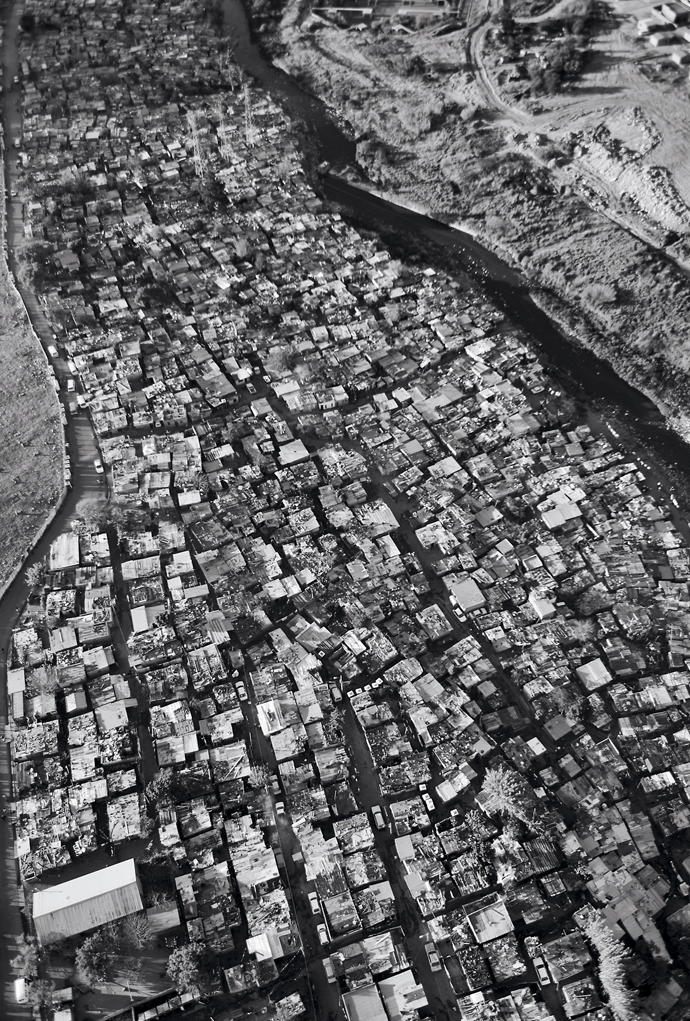
Aerial view of Diepsloot township, Johannesburg © Martin Harvey/Getty Images
One day, Roche and I drove to a farm in Limpopo, where there had been a rash of farm attacks and land grabs, and where a few farms had already been redistributed under the scheme of “willing buyer, willing seller” reform. These farms had subsequently fallen apart—the people who’d been given them didn’t have the money to buy expensive machinery and stock animals, and so they’d sold or eaten the giraffes and kudu, cut the trees of the bushveld, and stripped the houses of anything salable. It was the classic modern economic tragedy—good intentions and piecemeal reform can’t solve the problem of poverty in a world where access to capital is the fundamental avenue to success—and the farms now lay in ruins.
On Roche’s friend’s land, where prize game were bred for sale and hunts, I sat for some time with the farm’s owner, a tough old Anglophone named Rodney Mitchell, and his son, a lithe twenty-seven-year-old named John James. They looked at the issues very practically.
“The problem is that we’re sitting with these masses and masses of people unemployed,” Mitchell told me, “which is getting worse. And a lot of people below the bread line. And that in itself is a big problem, because once you have these big masses it’s very easy when someone like Malema says, ‘We’re going to give you a farm.’ And those guys are getting stronger.”
But while they were suspicious of the new breed of agitators, even they—white farmers—weren’t opposed to all land reform. “You can say whatever you want,” John James said, about the farms in the area that the government had already come in and redistributed. “But it was in a sense fair.”
I noticed at one point the butt of a 9mm sticking out from under John James’s khaki shirt. It turned out that he was part of a self-defense group that the local farmers had formed, that he kept a gun and a radio on him at all times, and that calls came in at least several times a month that had him loading up the truck and going to a farm to hunt in the bush for attackers. His father had talked about how he’d fought in Angola and knew bush warfare and how to track an enemy by night, and it seemed slightly insane to Mitchell that his quiet and gentle son, who ran the family’s hunting operation but refused to shoot animals himself, was now carrying on the legacy in their own neighborhood, so long after peace was supposed to have come.
“I’m very reasonable with this type of stuff,” John James said, looking sadly away from me when I asked how many of these encounters turned violent. He wouldn’t say whether he’d ever had to shoot someone. “My assumption of a lot of these farm attacks and farm murders is that farmers are treating these guys badly.” And it’s true—many of the murders are unnecessary but not entirely surprising culminations of years of tension, such as when, in 2010, Eugène Terre’Blanche, the rabidly racist leader of the Afrikaner separatist AWB militia and one of the most famous political figures in South Africa, was hacked with a machete and beaten to death with a pipe by at least one aggrieved farmworker, who had not been paid for the month, and who allegedly later announced to the other workers, “I am your boss today.”
That night, Roche and I dined with Mitchell and ate steaks as thick as the dictionary and spun-sugar desserts, and then slept in luxury safari tents overlooking the game park. We left the next morning and went to meet a private security force in Krugersdorp, near Johannesburg, where Mutavhatsindi, the black farmhand, had been shot and killed. Roche wanted to help a friend get his hands on a Saracen armored personnel carrier that a contact in the area didn’t have any use for, and after some phone calls we went over to kick the tires. “What I want is to see this thing, you know, running over protesters with petrol bombs,” the man giving it away said, as an old Afrikaner in a sky-blue Versace shirt fiddled with the carburetor. “We should put a GoPro on it,” someone said, “so you can watch.”
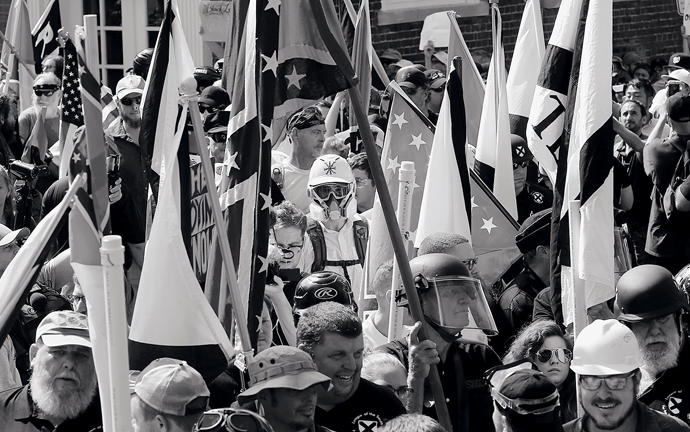
White-supremacist demonstrators, including Simon Roche, bottom right in a white hard hat, walk into Lee Park surrounded by counterdemonstrators in Charlottesville, Virginia, August 12, 2017 © AP Photo/Steve Helber
Just before I left South Africa, I drove to KwaZulu-Natal, to join Roche and the Suidlanders’ leader, Gustav Müller, at a campout along the banks of a slow little river, where crocodiles and giant lizards lounged in the reeds. Thebe, my black driver and guide, understandably didn’t want to go anywhere near the gathering, and he drove on to meet some friends, leaving me outside a tightly guarded gate behind which 250 or so Suidlanders had come for a monthly gathering where they prayed, listened to speeches of dire warning and planned for the coming war.
I got there just in time to hear Roche give a speech to a rapt crowd huddled in the cold on the banks of the river. “You guys, being white,” he told them, “represent the very stupidest people in South Africa. Because you represent those who will believe anything.” He said that they’d been lied to for generations—conned into believing in the false promise that whites could find a home in the rainbow nation. He warned them about black Africans’ propensity for killing women and children, a propensity they had supposedly shown in wars that predated the white settlement of the interior and which, he claimed preposterously, went beyond anything Europeans had exhibited in all the great wars of the past few centuries. They couldn’t see the danger, because they had been told that all races, their neighbors and fellow citizens, were equal. “We are being enveloped in layer upon layer of lies.” He wanted them to know that there was a plan at work. He began to bellow and wave his arms. “It is not about the land. It has got nothing to do with the land.” It was about a plot to destroy whites, and they needed to be ready.
After the speech, Roche said he wanted to go buy cigarettes. We drove out into the countryside, past white-owned farms where warthogs and kudu ranged against the fence lines, and the only place we found open was a big old country hotel, built in a faux-Tudor style. We went in to see if they sold cigarettes at the bar. We bought some, and Roche noted wistfully that the camp was a booze-free zone. “How about a quick one now?” he said.
Roche spoke to the young black bartender in Zulu, which he had learned working alongside blacks in his twenties, back in the days when he still believed in the promise of a multicultural South Africa, and we got a couple rum and cokes and sat down. “As a matter of interest,” he said, “and you’re free not to answer. But what do you tell Mophethe”—my guide—“about me when you talk to him?”
The question didn’t surprise me. Roche had the tendency, in common with a certain kind of American, to regard black people as inferior and as his political enemies, even as he seemed to like them and care what they thought of him. Finally, I said that I told Thebe that Roche was racist, and that I thought it was unfortunate that this was how things had turned out—because I didn’t think that caring about a people, or having a sense of historical identity, or however you wanted to put it, had to be an exclusionary project. I told him that I’d met Andile Mngxitama. Roche seemed surprised and intrigued—Mngxitama was the clearest representation of the forces he had set himself against. I told him that, as I saw it, their politics weren’t really so different—that they both saw the post-apartheid South Africa as an unfinished revolutionary project, one that had brought nominal political equality but had left the basic economic reality of white supremacy intact. I said that I thought the white nationalists and the black radicals understood power as a much more concrete substance than Western liberals had been willing to see it over the past several decades. The two groups of South Africans didn’t see a world where constant growth and globalization would solve all problems by default. They saw power as a finite, divisible resource—to which the obvious corollary was that it was something that could be fought over, and won. I said that I thought this was more or less the way the world was headed, and I said that lately I found it easier to trust and talk to people who saw things in these clear terms, because I felt as though I’d grown up in a world that had been lying to itself, pretending that the realities of power and limited resources didn’t exist. And I said that, to be totally honest, there was a large part of me that wouldn’t care at all if history finally caught up to the white South Africans, the revolution finally came, and they were either forced to bend the knee or flee the country. But I knew that if white people in the United States—even liberals who like to congratulate themselves for being such fine antiracists—had to face an imminent, concrete, and irrevocable loss of economic and political power, they might suddenly find themselves feeling far less solidarity with the oppressed than they’d like to imagine. This is the true reality of confronting white supremacy that I’d learned in South Africa: it means white people giving things up.
Roche paused for a very long time. We drank a few more drinks as he explained that he hadn’t expected a response “quite so radical.” I covered the bill. I tipped the bartender heartily, and he said something in Zulu that obviously affected Roche very much. We got to the truck, and he tried to explain. “He didn’t say simply ‘thank you,’” Roche said. “He said something deeper—in Zulu, it means, I am grateful for you. It’s a very significant way to put something.” He put his hand to his forehead. “It’s moments like this,” he said, “when I question some of the people I have made my allies. But now it’s the only path.”
He seemed to relish having chosen a side, to have a politics to fall back on when complicated moments like this arose. And he had relished talking about Andile Mngxitama, an adversary who had chosen a side just as he had, and who spoke plainly about making whites bow down in the face of a black power that Roche was convinced was swelling and would soon engulf the country. “If that’s how Andile sees it, then I respect it a great deal,” he said. “To that I only say we must fight it out, and let’s die like men.”

